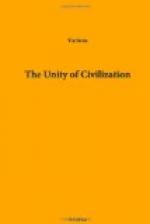These novels, however, which appeared between 1730 and 1740, are overshadowed by the works of the great Englishmen, by Richardson and Sterne and Goldsmith, for these are not artists of England alone, but of all Europe, known and loved and imitated in every country in Europe. The sorrows of Clarissa, the pathetic or maudlin humour of Sterne, the idyllic grace and gentle laughter of Goldsmith, these, as they moved every heart, influenced even the greatest of European artists. The influence of Clarissa on Rousseau, of Goldsmith on Goethe and Jean Paul Richter need no exposition.
The sentimental movement reached almost its highest level in the great and morbid genius of Rousseau, who was himself the living embodiment of the movement. Far more than even his creations, more than Julie or Saint-Preux, was he himself possessed by an emotionalism which finally became a disease. But, strangely enough, it was the Olympic genius of Goethe which gave its supreme form to the treatment of life under the terms of feeling. In Werther this whole phase of art passed beyond itself into the tragedy of the vain and hopeless efforts of an honest but over-sensitive nature to control his emotion and to master his life. Not indeed that it was with Werther the movement ended: it was continued in Byron: it was perhaps the most important element in what the Germans call specifically their Romantische Schule, and in the work of the French Romantic artists from Chateaubriand to Alfred de Musset. If you wish to see it in painting you have only to look at the work of Greuze, and at the engravings in our grandmothers’ ‘Forget-me-nots’. In spite of all its absurdities this sentimental movement played a great part in preparing men for the great revolution itself, for it opened men’s hearts, it set free their emotions; if the realism of Defoe and Hogarth had enabled men to escape from convention and the mannerisms of good taste into a world of reality, the emotional movement gave this reality fullness and content, represented a larger and more intimate apprehension of life.
This brings us to another aspect of the art of the seventeenth and eighteenth centuries, to the poetry and painting of ‘nature’, to the beginnings of that great artistic movement which culminates in Wordsworth and Turner, and whose influence dominated all Europe in the eighteenth century and continues to do so in our own time. It seems a strange thing, but it is true, that it was not till the seventeenth and eighteenth centuries that there appeared a school




